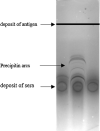Investigation of the value of precipitins in severe acute respiratory syndrome coronavirus 2 (SARS-CoV-2) patients with a positive marker for Aspergillus species
- PMID: 35604675
- PMCID: PMC9213863
- DOI: 10.1093/mmy/myac031
Investigation of the value of precipitins in severe acute respiratory syndrome coronavirus 2 (SARS-CoV-2) patients with a positive marker for Aspergillus species
Abstract
Although a high prevalence of COVID-19-associated pulmonary aspergillosis has been reported, it is still difficult to distinguish between colonization with Aspergillus fumigatus and infection. Concomitantly, similarities between severe acute respiratory syndrome coronavirus 2 (SARS-CoV-2) and hypersensitivity pneumonitis were suggested. The objective of this study was to investigate retrospectively if precipitin assays targeting A. fumigatus could have been useful in the management of SARS-CoV-2 patients hospitalized in an Intensive Care Unit (ICU) in 2020. SARS-CoV-2 ICU patients were screened for Aspergillus co-infection using biomarkers (galactomannan antigen, qPCR) and culture of respiratory samples (tracheal aspirates and bronchoalveolar lavage). For all these patients, clinical data, ICU characteristics and microbial results were collected. Electrosyneresis assays were performed using commercial A. fumigatus somatic and metabolic antigens. ELISA were performed using in-house A. fumigatus purified antigen and recombinant antigens.Our study population consisted of 65 predominantly male patients, with a median ICU stay of 22 days, and a global survival rate of 62%. Thirty-five patients had at least one positive marker for Aspergillus species detection. The number of arcs obtained by electrosyneresis using the somatic A. fumigatus antigen was significantly higher for these 35 SARS-CoV-2 ICU patients (P 0.01, Welch's t-test). Our study showed that SARS-CoV-2 ICU patients with a positive marker for Aspergillus species detection more often presented precipitins towards A. fumigatus. Serology assays could be an additional tool to assess the clinical relevance of the Aspergillus species in respiratory samples of SARS-CoV-2 ICU patients.
Lay summary: This study showed retrospectively that precipitin assays, such as electrosyneresis, could be helpful to distinguish between colonization and infection with Aspergillus fumigatus during the management of severe acute respiratory syndrome Coronavirus-2 (SARS CoV-2) patients in an intensive care unit.
Keywords: Aspergillus fumigatus; SARS-CoV-2; electrosyneresis; precipitins; somatic antigen; tracheal aspirates.
© The Author(s) 2022. Published by Oxford University Press on behalf of The International Society for Human and Animal Mycology.
Figures



Similar articles
-
Systematic screening for COVID-19 associated invasive aspergillosis in ICU patients by culture and PCR on tracheal aspirate.Mycoses. 2021 Jun;64(6):641-650. doi: 10.1111/myc.13259. Epub 2021 Mar 5. Mycoses. 2021. PMID: 33606324 Free PMC article.
-
COVID-19-Associated Invasive Aspergillosis: Data from the UK National Mycology Reference Laboratory.J Clin Microbiol. 2020 Dec 17;59(1):e02136-20. doi: 10.1128/JCM.02136-20. Print 2020 Dec 17. J Clin Microbiol. 2020. PMID: 33087440 Free PMC article.
-
SARS-CoV-2 and Aspergillus section Fumigati coinfection in an immunocompetent patient treated with corticosteroids.Rev Iberoam Micol. 2021 Jan-Mar;38(1):16-18. doi: 10.1016/j.riam.2020.11.001. Epub 2020 Nov 28. Rev Iberoam Micol. 2021. PMID: 33500209 Free PMC article.
-
COVID-19 associated with pulmonary aspergillosis: A literature review.J Microbiol Immunol Infect. 2021 Feb;54(1):46-53. doi: 10.1016/j.jmii.2020.09.004. Epub 2020 Sep 24. J Microbiol Immunol Infect. 2021. PMID: 33012653 Free PMC article. Review.
-
A review of significance of Aspergillus detection in airways of ICU COVID-19 patients.Mycoses. 2021 Sep;64(9):980-988. doi: 10.1111/myc.13341. Epub 2021 Jul 1. Mycoses. 2021. PMID: 34143533 Free PMC article. Review.
Cited by
-
Aspergillus-SARS-CoV-2 Coinfection: What Is Known?Pathogens. 2022 Oct 25;11(11):1227. doi: 10.3390/pathogens11111227. Pathogens. 2022. PMID: 36364979 Free PMC article. Review.
-
Risk factors and the value of microbiological examinations of COVID-19 associated pulmonary aspergillosis in critically ill patients in intensive care unit: the appropriate microbiological examinations are crucial for the timely diagnosis of CAPA.Front Cell Infect Microbiol. 2023 Nov 21;13:1287496. doi: 10.3389/fcimb.2023.1287496. eCollection 2023. Front Cell Infect Microbiol. 2023. PMID: 38076456 Free PMC article.
References
-
- Selman M, Pardo A, King TE Jr.. Hypersensitivity pneumonitis: insights in diagnosis and pathobiology. Am J Respir Crit Care Med. 2012; 186: 314–324. - PubMed
MeSH terms
Substances
LinkOut - more resources
Full Text Sources
Medical
Miscellaneous

